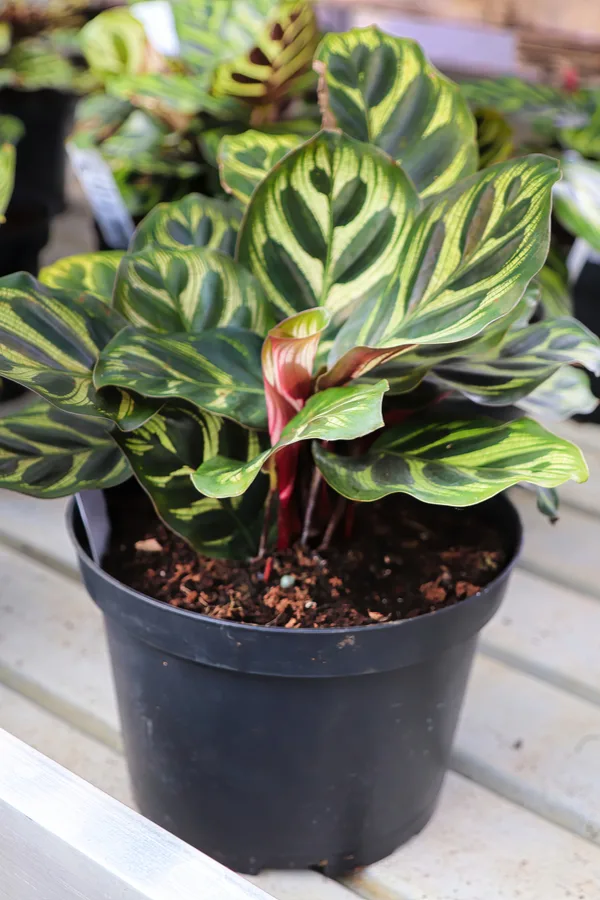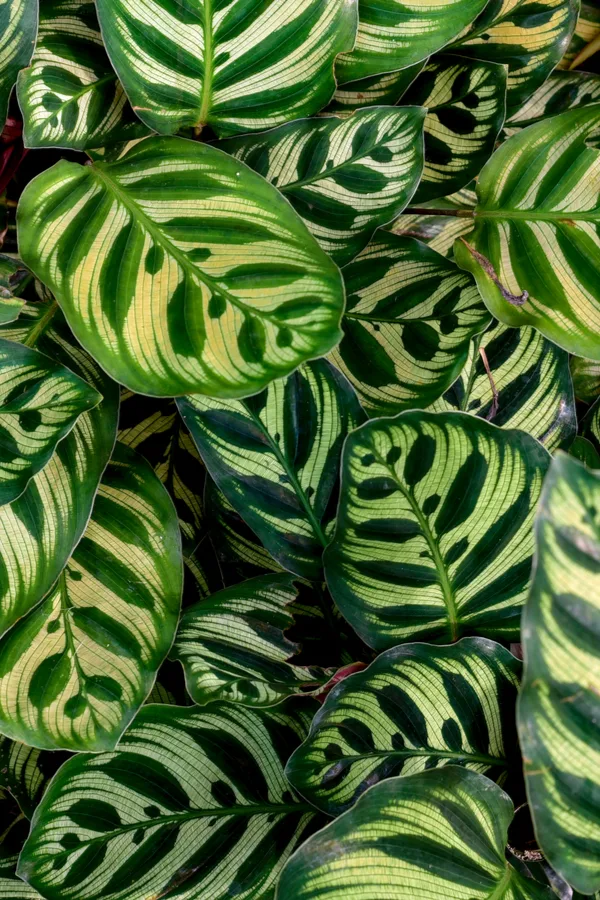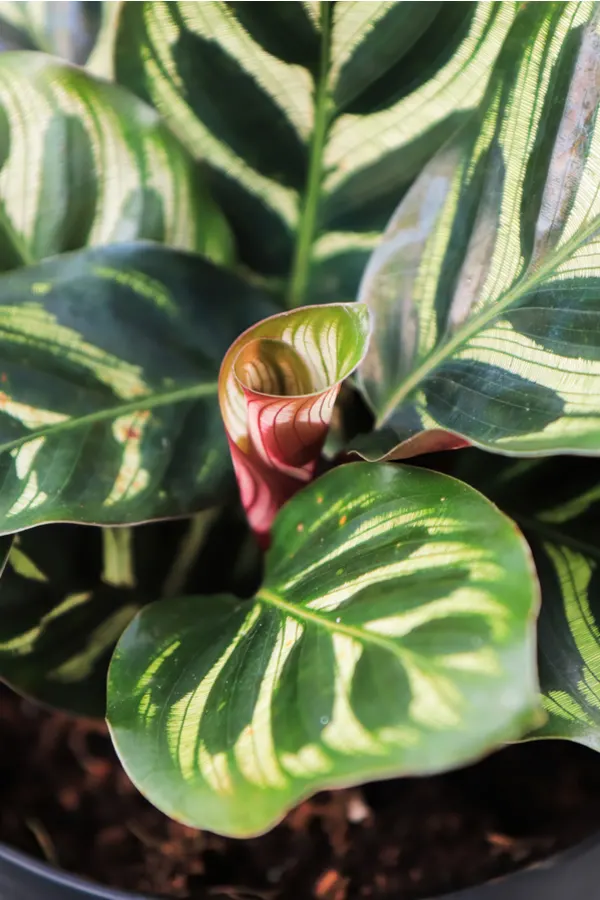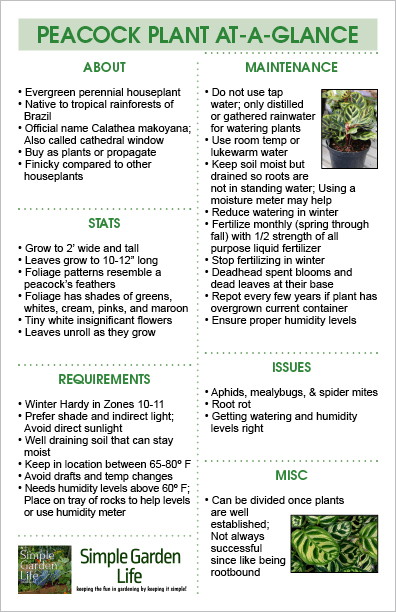Officially known as Calathea makoyana, a peacock plant is a beautiful evergreen perennial that is incredible to grow as a houseplant indoors. While it isn’t the best choice for a novice grower, if you follow a few simple tips, you can grow and enjoy this stunning houseplant for many years to come!
The peacock plant is native to the tropical forests of Brazil, which makes it a shade and humidity-loving plant. In fact, direct sunlight will often burn its sensitive leaves.
The foliage of the non-toxic peacock plant is what really makes this plant stand out and gives it its name. It features tall, thin stems that have oval-shaped leaves that can be 10 to 12 inches long. The leaves have a dark and light green “feathered” look to them that makes them similar in appearance to a peacock’s tail.
While they are winter hardy in Growing Zones 10-11, most people keep peacock plants as houseplants. (You can find your Growing Zone Here).

Varieties of Peacock Plants – How To Grow Peacock Plants
You may have heard the plant called cathedral windows or even prayer plants, but there are many other species that are also called prayer plants. (During the nighttime, their leaves curl up, which makes them appear like they are in prayer)
The peacock plant grows around 2 feet tall and wide, which makes it a great plant when space might be an issue.
Their dominant colors are dark green and light green, but the stems of the peacock plant have reddish shades and the bottom sides of the leaves are dark purple/maroon. New emerging leaves are curled-up and are pink in color before they fully unroll.
Peacock plants do produce white flowers, but they are small and fairly insignificant. Their blooms appear sporadically throughout the growing season. The foliage is really what draws people to this stunning houseplant.
How To Plant, Grow, And Maintain Peacock Plants
Soil Requirements for Peacock Plants
A basic potting soil mixture should be adequate for growing peacock plants. The most important factor is that the soil is able to be kept moist while still draining well.
Adding organic matter in with the potting mix will help not only provide extra nutrients to the plant but also aid in draining. Just make sure not to use a potting mix that is made for succulents or other plant-specific soil mixes.
Planting – How To Grow A Peacock Plant Indoors
Peacock plants can be purchased as a starter plant from your local garden nursery, or can also be created from propagating.
If you are going to repot the peacock plant from its original container, make sure to choose one that has adequate drainage holes. Grabbing low on the plant, carefully pull the peacock plant from the original container. Loosen the soil around the roots and place it in a new container filled partially with potting soil. You can even place an inch or two of rocks at the bottom of the container to allow for better drainage.
Back fill the plant, adding in organic matter or sand if wanted for additional drainage. Water thoroughly until the soil is completely moist and additional water begins to flow through the drainage holes.

During the warmer months, you can choose to keep peacock plants outdoors until temperatures reach 55º Fahrenheit (13º Celsius) or below. However, they are so particular about humidity and sunlight that they really do much better indoors as houseplants.
Long-Term Care – How To Grow and Maintain A Peacock Plant Indoors
As mentioned earlier, peacock plants aren’t for beginner growers, but don’t let that scare you off from owning them. While they have very specific requirements when it comes to watering, humidity, and light, you can successfully keep them healthy and thriving by following these tips.
Watering
Adequate and proper watering is probably the most important aspect when it comes to keeping your peacock plants healthy.
Unfortunately, you cannot simply use tap water for your peacock plants. Distilled water or captured rainfall water is the best option. Peacock plants are very sensitive to the fluoride that is in tap water in addition to water that is too soft or too hard. Excess fluoride in your water can cause leaf edges to brown.
In addition, the water should be at room temperature or even lukewarm when watering since cold water can shock the plants’ roots.
Another issue with watering is getting the right balance between keeping soil moist while not over watering. Using a moisture meter can help you know for sure when your peacock plant needs watering. Product Link : Moisture Probe Meter
If your peacock plant’s leaves start to yellow, the plant likely is being overwatered. If the leaves are turning brown, then the plant needs more water. The plants will require less watering during the winter season when they aren’t actively growing, so make sure to keep that in mind as well.
Humidity
In addition to proper watering, peacock plants thrive in humid environments. Aim for a relative humidity level of 60% or higher. If levels are less than that, the leaves may start to brown and curl up.
Misting the leaves can help, but the best way to achieve a constant higher humidity level is to place your potted container on top of a tray filled with rocks. Any of the excess water that has drained from the plant will stay in the rock-filled tray and help add humidity without the plant’s roots sitting in standing water. Placing a humidifier nearby will help as well if needed.
Temperature
Since peacock plants are tropical plants, aim for a room temperature of around 65-80º Fahrenheit (18-27º Celsius). Avoid extreme changes in temperature. Also, keep peacock plants away from areas where there are hot or cold drafts such as open windows or heating vents.
Light
Peacock plants thrive in low-light or shady conditions. Place plants near a west or north-facing window where they can receive indirect sunlight. Never place plants in direct sunlight since the heat and light can burn their delicate foliage.
Fertilizing
These perennial plants should be fertilized once a month during their growing season (spring through fall). Use half strength of an all-purpose liquid fertilizer. An NPK(nitrogen, phosphorous, potassium) mixture of 3-1-2 is recommended, but any type of liquid all-purpose fertilizer will work as long as it is diluted. Stop fertilizing during the winter months.
Deadheading
As with most houseplants, remove any dying or dead leaves and flowers. Use a sharp pair of pruners or scissors to cut the dead stem at the base of the plant.
While peacock plants aren’t prolific blooming plants, their spent blooms should still be deadheaded as well. Check out this podcast for an in-depth look at properly deadheading perennials to keep them looking beautiful: “How To Deadhead Annuals And Perennials.”
Pests & Issues
As with most houseplants, basic pests like aphids, mealybugs, and spider mites might be problematic. Ensure that plants have plenty of airflow and proper moisture levels. Root rot can also be a problem if the plant’s container doesn’t have adequate drainage holes.

Repotting & Propagating – How To Grow A Peacock Plant Indoors
Peacock plants tend to grow slowly, so they should only need to be repotted every few years. Choose a container that is a few inches larger than the current container. Make sure it also has good drainage holes. If not, add more if possible.
These plants can be propagated, but make sure the plant is healthy and well established before attempting to divide. Peacock plants actually thrive with tight root clumps, so it isn’t always successful to divide even an established plant.
When you go to propagate, carefully remove the entire plant from the container and split the crown and root ball into half using a sharp spade or a Hori Hori tool. Place each half into new containers filled with potting soil and organic matter. Keep the soil moist and place plants in a location that is warm and has high humidity levels.
To Conclude…
While peacock plants might be a little more finicky than other houseplants, they produce such beautiful foliage that their displays are definitely worth a little extra hard work!
Feel free to download, print out, or save our Peacock Plant At-A-Glance sheet. It is sized for half letter printing but can be scaled if needed.



